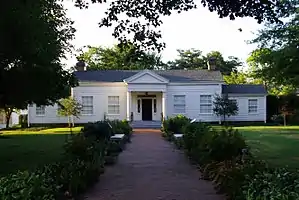Washington–Willow Historic District
Washington–Willow Historic District is a residential neighborhood of Fayetteville, Arkansas containing over one hundred historically and architecturally significant homes. Styles range from those popular in the mid-19th century through present day, predominantly Victorian, Italianate, neoclassical, and craftsman bungalows. Historically, Fayetteville leaders in business, law and education have all called the district home. The homes sit at the foot of East Mountain within the Masonic Addition, the first addition platted following incorporation.
Washington–Willow Historic District | |
 Alf Williams House, located within the district | |
| Location | Roughly bounded by College Ave. and Mission Blvd., Rebecca and Spring Sts., Fayetteville, Arkansas |
|---|---|
| Area | 37 acres (15 ha) |
| Architectural style | Late Victorian, Bungalow/craftsman |
| NRHP reference No. | 80000789[1] |
| Added to NRHP | May 23, 1980 |
Encompassing roughly 37 acres (0.15 km2), the district is bounded by College Avenue (U.S. Route 71B) on the west, Mission Boulevard on the east, Rebecca Street to the north, and Spring Street to the south. The primary streets within the district are the namesake Washington Avenue and Willow Avenue, crossing Davidson Street, Maple Street, Lafayette Street, and Dickson Street. The district was listed on the National Register of Historic Places in 1980, and its boundaries were increased in 1995.[1]
Structures
Although 105 structures were listed as "primary structures" on the initial 1980 submission, nineteen structures were listed to have special significance.
Headquarters House

Headquarters House, located at 118 East Dickson Street, is a historic house within the Washington–Willow Historic District in Fayetteville, Arkansas. The most historically significant structure in the city, it was built in 1853 and used as a base of operations for both the Union and Confederate States of America at different periods during the American Civil War. The house was the point of contention during the Battle of Fayetteville, which took place at the nearby intersection of College Avenue and Dickson Street.[2] Headquarters House was listed on the National Register of Historic Places in 1971, prior to the designation of the Washington–Willow Historic District.[1]
During the siege on April 18, 1863, the Union-occupied structure sustained damage from a Confederate cannonball striking the front door. The Union ultimately repelled the attack and was able to maintain control of northwest Arkansas.
A one-story weatherboard structure with fluted columns surrounding a central portico, the Headquarters House has significant elements of the Greek Revival style. The corners of the building possess decorative pilasters with transom and small sidelights adjacent to the doorway.[3] The building was donated to the Washington County Historical Society as a museum in 1967, a function it has maintained ever since.[2]
Significant structures
 306 Washington
306 Washington 310 Washington
310 Washington 329 Washington
329 Washington 348 Washington
348 Washington 308 Willow
308 Willow 503 Willow
503 Willow 504 Willow
504 Willow
Homes adding to the character of the district
 220 Lafayette
220 Lafayette 221 Lafayette
221 Lafayette 303 Sutton
303 Sutton 308 Washington
308 Washington 322 Washington
322 Washington 338 Washington
338 Washington 339 Washington
339 Washington 403 Washington
403 Washington 410 Washington
410 Washington 422 Washington
422 Washington 428 Washington
428 Washington 531 Washington
531 Washington 304 Willow
304 Willow 306 Willow
306 Willow 310 Willow
310 Willow 312 Willow
312 Willow 325 Willow
325 Willow 341 Willow
341 Willow 347 Willow
347 Willow 413 Willow
413 Willow 511 Willow
511 Willow 520 Willow
520 Willow 528 Willow
528 Willow 534 Willow
534 Willow 613 Willow
613 Willow
See also
References
- "National Register Information System". National Register of Historic Places. National Park Service. July 9, 2010.
- "Headquarters House". Historical Properties. Fayetteville, Arkansas: Washington County (Arkansas) Historical Society. 2007. Retrieved July 18, 2013.
- Newbern, Carolyn; Besom, Robert D. (February 25, 1980). "Washington–Willow Historic District" (PDF). National Register of Historic Places Registration. Arkansas Historic Preservation Program. Retrieved July 18, 2013.